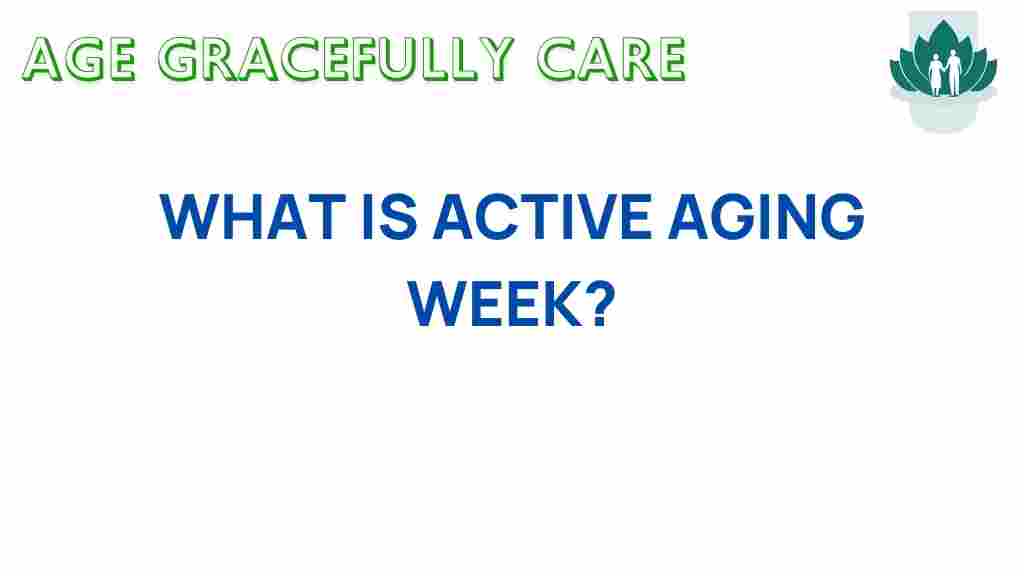Unlocking the Secrets of Active Aging
Active aging is more than just a lifestyle choice; it’s a holistic approach to living that emphasizes wellness, healthy living, and community engagement throughout the later stages of life. As we age, it becomes increasingly important to focus on maintaining our physical fitness, mental health, and social connections to live a vibrant life. This article will explore the various dimensions of active aging, providing you with a comprehensive guide to achieving vitality through fitness, lifelong learning, and meaningful interactions.
The Importance of Active Aging
Active aging is about making informed choices that promote health and well-being. With the right mindset and resources, individuals can enhance their quality of life, improve their physical and mental health, and foster a sense of community. Here are some key benefits of embracing active aging:
- Improved Physical Health: Regular exercise helps maintain strength, flexibility, and endurance.
- Enhanced Mental Health: Staying active can reduce symptoms of depression and anxiety.
- Social Connections: Engaging with others fosters friendships and combats loneliness.
- Lifelong Learning: Continuous learning keeps the mind sharp and promotes cognitive health.
- Increased Vitality: A vibrant life is characterized by energy and enthusiasm for new experiences.
Step 1: Embrace Wellness Through Fitness
Fitness is a cornerstone of active aging. Engaging in regular physical activity not only enhances your physical health but also positively impacts your mental well-being. Here are some ways to incorporate fitness into your daily routine:
- Start Small: If you’re new to fitness, begin with short sessions of low-impact exercises such as walking, swimming, or cycling.
- Set Goals: Establish realistic fitness goals that align with your lifestyle and capabilities.
- Join a Class: Participating in group fitness classes can provide motivation and social interaction.
- Incorporate Strength Training: Strength training at least twice a week can help maintain muscle mass and bone density.
- Stay Consistent: Aim for at least 150 minutes of moderate aerobic activity each week, coupled with muscle-strengthening activities.
Step 2: Prioritize Mental Health
Mental health is just as crucial as physical health in the journey of active aging. Here’s how you can prioritize your mental well-being:
- Practice Mindfulness: Techniques such as meditation and yoga can help reduce stress and enhance emotional resilience.
- Stay Engaged: Find hobbies and activities that challenge your brain, such as puzzles, reading, or learning a new skill.
- Seek Support: Don’t hesitate to reach out to friends, family, or professionals if you’re feeling overwhelmed.
- Maintain Routine: Establishing a daily routine can provide structure and promote a sense of normalcy.
Step 3: Foster Social Connections
Social connections are essential for emotional health and can significantly contribute to your overall well-being. Here are ways to strengthen your social networks:
- Volunteer: Engaging in community service can create a sense of purpose and introduce you to new friends.
- Join Clubs or Groups: Look for local clubs related to your interests, such as book clubs, gardening groups, or sports teams.
- Attend Community Events: Participate in local events to meet new people and stay connected with your community.
- Stay in Touch: Regularly communicate with friends and family, whether through phone calls, video chats, or social media.
Step 4: Engage in Lifelong Learning
Lifelong learning is vital for cognitive health and personal growth. Here are ways to keep your mind active:
- Take Classes: Enroll in classes at local community colleges or online platforms to learn new skills.
- Attend Workshops: Participate in workshops that interest you, ranging from art to technology.
- Read Widely: Make a habit of reading books, articles, and other materials to broaden your knowledge.
- Explore New Topics: Challenge yourself by learning about subjects outside your comfort zone.
Step 5: Cultivate a Healthy Lifestyle
Healthy living is at the heart of active aging. Adopting a balanced lifestyle can significantly impact your well-being. Focus on the following areas:
- Nutrition: Aim for a balanced diet rich in fruits, vegetables, whole grains, and lean proteins.
- Hydration: Drink plenty of water to stay hydrated, as it’s essential for bodily functions.
- Sleep: Prioritize quality sleep to support physical and mental health.
- Avoid Harmful Habits: Limit alcohol consumption and avoid smoking or other harmful substances.
Community Engagement: A Vital Component of Active Aging
Community engagement fosters a sense of belonging and purpose. Here’s how to get involved:
- Connect with Local Organizations: Identify local organizations or charities that resonate with your values.
- Participate in Local Government: Attend town hall meetings or local events to stay informed and engaged.
- Start a Community Initiative: If you’re passionate about a cause, consider starting an initiative that brings others together.
Troubleshooting Common Challenges in Active Aging
While the journey of active aging is rewarding, you may encounter challenges. Here are some common issues and tips to overcome them:
- Finding Motivation: If you’re struggling to stay motivated, consider partnering with a friend or joining a group for accountability.
- Physical Limitations: Consult with a healthcare provider to tailor an exercise program that suits your abilities.
- Social Isolation: Make a conscious effort to reach out to friends or join new social circles to combat feelings of loneliness.
- Time Constraints: Prioritize activities and schedule them into your week to ensure you make time for wellness.
Conclusion: Embracing a Vibrant Life
Unlocking the secrets of active aging is about embracing a holistic approach that incorporates fitness, mental health, social connections, and lifelong learning. By focusing on wellness and healthy living, you can enhance your quality of life and enjoy a vibrant existence well into your later years. Remember that it’s never too late to start making changes that promote vitality and well-being.
For more resources on active aging, consider visiting this comprehensive guide. And to explore local community events and activities, check out this site for opportunities near you.
Start today! Your journey toward active aging begins with a single step.
This article is in the category Wellness and created by AgeGracefullyCare Team
